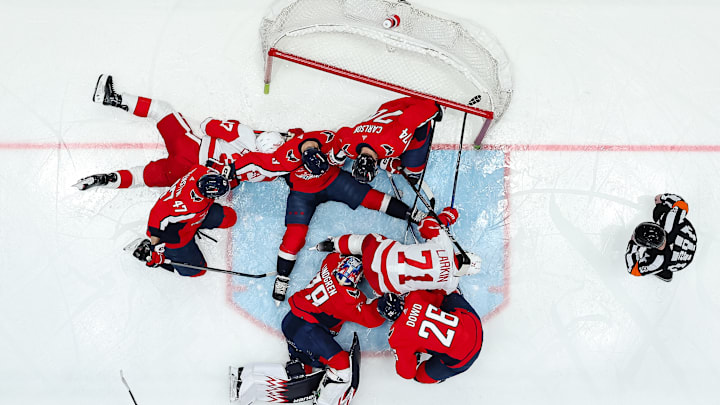Heading into the final two games of the 2023-2024 season, the Detroit Red Wings find themselves in contention for the playoffs. Such a scenario would have been a lofty season goal for Red Wings fans just a few months ago. However, six weeks back, the team was flying high, with a near-assured playoff berth. On February 29, 2024, they held an 8-point cushion for the final wild card position and were just 4 points behind Toronto for a top-three divisional seed. Then things started to unravel.
Currently, the Detroit Red Wings are tied with Washington and Philadelphia, with Pittsburgh trailing by just one point. They must secure one more point than each of the three teams to clinch a playoff spot. But how did we go from a season of promise to barely holding on?
Winning just three games in March hardly constitutes a recipe for success. It is easy to attribute such outcomes to random events or speculate whether this performance reflects the team's true capabilities, dismissing the earlier success in January and February as mere luck. However, as reported by Jonathon Mills, Derek Lalonde commented after the April 13 overtime victory against Toronto, “Self-evaluation in the offseason, there’ll be a lot to look at, and it’s been a unique up-and-down season.”
The Elements of the Spring Collapse
Despite ranking 18th in man games lost to injury this season, the Red Wings have not fared particularly poorly in this regard. However, the type and timing of these injuries have posed significant challenges. For instance, Dylan Larkin's three-week absence coincided with the team's downturn. Ville Husso's injury tested the depth in goal, while Jake Walman's absence disrupted an already fragile defense and deprived the team of a high-energy player. Michael Rasmussen's defensive contributions have also been sorely missed. Moreover, the timing of these injuries proved particularly detrimental, occurring during challenging road trips and against formidable competition.
During the same period, a bout of the flu swept through the team, with most players soldiering on despite feeling unwell. Reports surfaced of multiple players struggling to keep their food down, experiencing poor sleep, or playing with a fever, all of which contributed to the team's subpar performances. Notably, there were several lackluster efforts during the peak of the flu outbreak, such as both losses to Arizona.
The grueling and protracted season took its toll on the remaining players. Moritz Seider has showcased his resilience, but shouldering the burden of playing the toughest minutes against top opponents has undoubtedly worn him down. Ben Chiarot has enjoyed a commendable season, yet he noticeably loses steam in the third period or toward the end of lengthy shifts. Likewise, Alex Lyon's performance has dipped as he has been tasked with a heavy workload, a consequence of Ville Husso's absence.
Lack of “pure talent” wins also puts pressure on teams. No team can bring their A-game consistently throughout the year. Yet, top teams find ways to secure positive results in many of their C-level games, whether through outstanding goaltending, capitalizing on the few scoring opportunities they earn, or scoring goals against the run of play. Red Wings fans can recall the 2002 team, which at times appeared to coast through games, only to be bailed out by exceptional plays from superstars like Sergei Fedorov or Brett Hull.
Such challenges are common to all teams, but at this stage in the rebuild, the Red Wings lack the necessary depth and talent to overcome these obstacles regularly. There are exceptions, such as Simon Edvinsson seamlessly stepping into the lineup due to injury and significantly elevating the performance of the entire defensive unit or Raymond's transition from a complementary player to a driving force on the team.
The recent slump has prompted some fans to question whether the Yzerplan is a failure and whether Derek Lalonde should be dismissed. However, these inquiries seem premature and overly harsh. Although impatience is understandable, these questions overlook the fact that the primary objective at the beginning of the season was to play meaningful games in April, a goal that has been achieved.
What Will Change for Next Year to Make Success Sustainable?
The Red Wings are not particularly young on the ice this year. They have no rookies (aside from Simon Edvinsson this month) but boast a young core. However, this dynamic is expected to change come fall, with potentially three rookies joining the Detroit roster (Edvinsson, Albert Johansson, and Marco Kasper). Additionally, players like Nate Danielson, William Wallinder, and Carter Mazur are edging closer to NHL readiness. Also, there is a slim but non-zero chance that Axel Sandin-Pellika could make a significant and early leap to the NHL next season.
In terms of speed, the Red Wings are built to play a fast-paced game, but many players on this year's roster do not match the system's need for speed. The infusion of youth should address this issue.
Furthermore, the team needs more depth. A deeper roster is less susceptible to wearing down over the course of a long season, better equipped to handle illnesses and injuries, and capable of providing some players with much-needed breaks from consistently playing the toughest minutes in every game. In addition to the young players coming up, adding a goalie and strong forechecking winger with speed can improve the depth.
The Most Auspicious Development
Despite the collapse, an important ingredient on the road to being a cup contender has been established. As Derek Lalone finished his quote, “But it’d be really hard to knock this team’s compete and mental toughness. That’s pretty impressive.”
